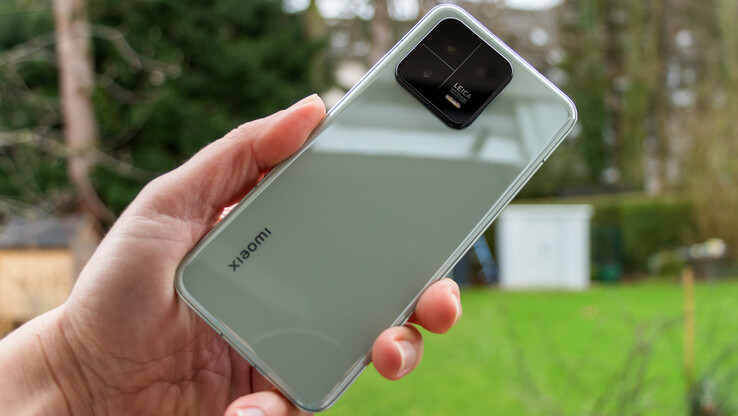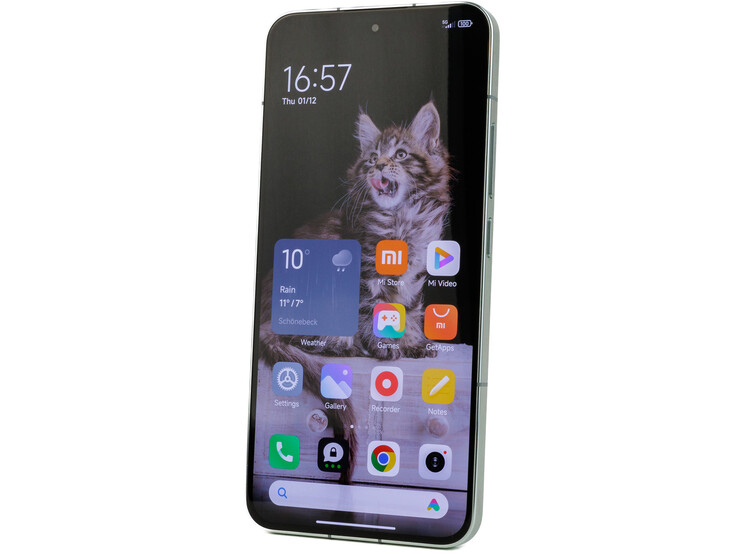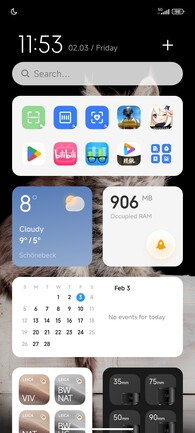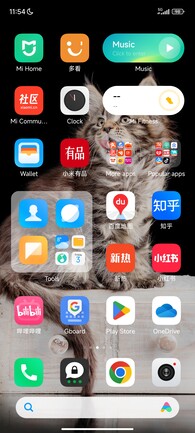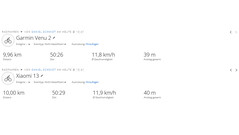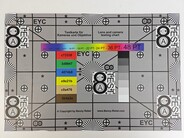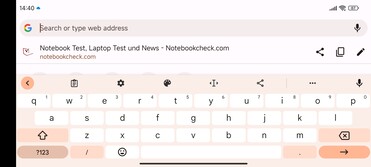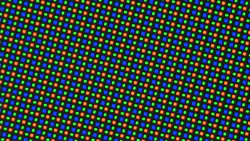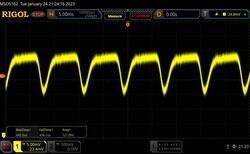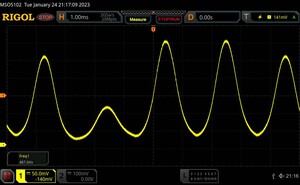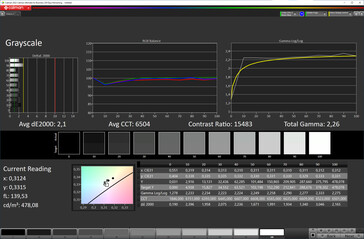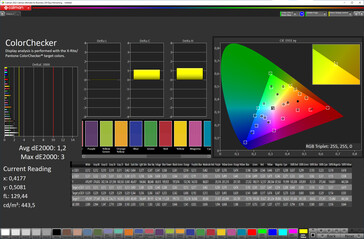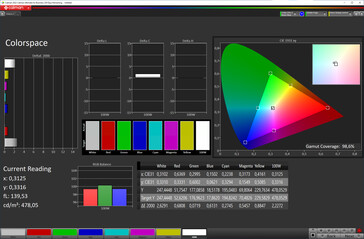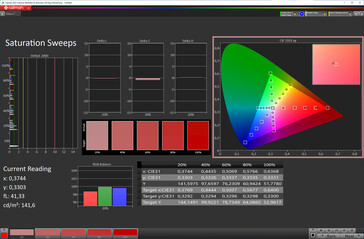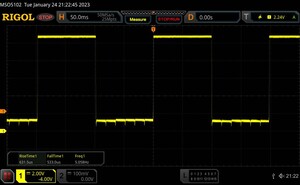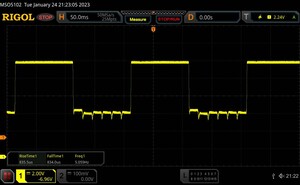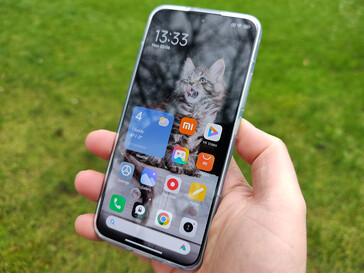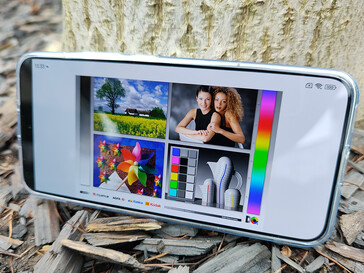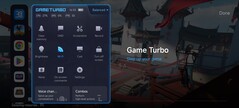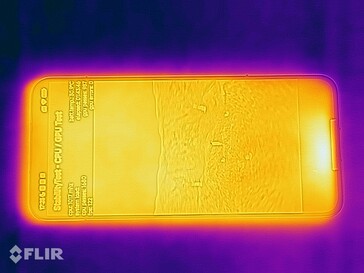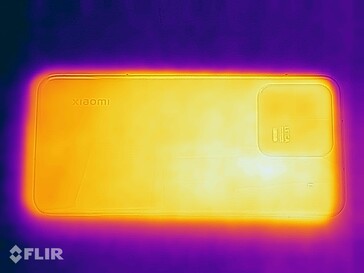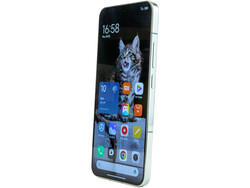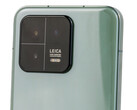Xiaomi 13 review - Compact powerhouse with Leica camera
The Xiaomi 13 is the follow-up to last year's Xiaomi 12 and stays true to the series by being a compact high-end smartphone. The display on the 13 is only marginally larger. And as expected, the phone once again features Qualcomm's latest flagship SoC – this time around the Snapdragon 8 Gen 2.
Whilst the device shares a lot of the same specs as its predecessor, Xiaomi has completely revamped the camera setup. We are referring not just to the cooperation with Leica, but also to the sensors. Besides having a new main sensor, the camera module is now equipped an optical zoom lens rather than a dedicated macro lens.
Our review unit is an import version from China. The international version of the Xiaomi 13 is expected to arrive in March (see our news coverage in German) and will reportedly cost €999 (US$1073). If you decide to purchase an import model, the phone can be had for much lower than €800 (US$860) from retailers.
Comparison with possible competitors
Rating | Date | Model | Weight | Drive | Size | Resolution | Price |
|---|---|---|---|---|---|---|---|
| 89.1 % v7 (old) | 02 / 2023 | Xiaomi 13 SD 8 Gen 2, Adreno 740 | 189 g | 256 GB UFS 4.0 Flash | 6.36" | 2400x1080 | |
| 89.3 % v7 (old) | 05 / 2022 | Samsung Galaxy S22 Exynos 2200, Xclipse 920 | 167 g | 128 GB UFS 3.1 Flash | 6.10" | 2340x1080 | |
| 89.3 % v7 (old) | 10 / 2022 | Motorola Edge 30 Ultra SD 8+ Gen 1, Adreno 730 | 198.5 g | 256 GB UFS 3.1 Flash | 6.67" | 2400x1080 | |
| 89.1 % v7 (old) | 11 / 2022 | Google Pixel 7 Pro Tensor G2, Mali-G710 MP7 | 212 g | 128 GB UFS 3.1 Flash | 6.70" | 3120x1440 | |
| 89.2 % v7 (old) | 04 / 2022 | Oppo Find X5 Pro SD 8 Gen 1, Adreno 730 | 221 g | 256 GB UFS 3.1 Flash | 6.70" | 3216x1440 | |
| 90.3 % v7 (old) | 01 / 2023 | Apple iPhone 14 Pro A16, A16 GPU 5-Core | 206 g | 256 GB NVMe | 6.10" | 2556x1179 |
Case - Glass and aluminium design feels great in the hand
The Xiaomi 13 is available in a host of colours on the Chinese market: black, white, blue (pleather finish) and jade green, which is the colour of our review unit. In China, the company is also offering limited-edition models in Flame Red, Sapphire Blue, Hurricane Yellow, Jungle Green and Cement Gray.
The front and back of the phone are protected by Corning Gorilla Glass Victus and feel good to the touch, but they are real fingerprint magnets. The same goes for the glossy polished aluminium frame. The device is very well built, and all the gaps on the chassis are tight and even. The SIM slot's cover is made of the same material as the frame and forms a whole with the frame that looks and feels clean.
Design-wise, the camera module now sets itself further apart from those on other Xiaomi phones and is featured prominently on the back, sticking out considerable 2.25 mm (0.09 inch) from the body. The Xiaomi 13 has an IP68 rating, meaning it is water resistant and protected from dust.
Specifications - Still only supports USB 2.0
As with its predecessor, the Xiaomi 13 is equipped with a USB-C port that doesn't support video output over a cable. But at least it is capable of OTG, thus enabling users to connect external peripherals and storage devices. Unfortunately, the interface only supports USB 2.0 and managed to achieve transfer speeds of just 37.7 MB/s during our testing.
The phone also doesn't have an audio jack or a microSD slot. In return, you'll get an IR blaster that lets you remotely control things like multimedia devices, air conditioners and cameras. The Xiaomi 13 also has Bluetooth 5.3, NFC and UWB capability (for turning the device into a digital car key).
In China, the flagship phone is available in four memory/storage configurations: 8/128 GB, 8/256 GB, 12/256 GB and 12/512 GB. Based on experience, there will likely be fewer options for the international version.
Software - Xiaomi 13 ships with Android 13 and MIUI 14
The Xiaomi 13 ships with the current Android 13. Our import version from China comes preinstalled with many Chinese apps. Google Play Store was missing on our review unit, but this can be easily remedied afterwards using an APK. However, if you purchase the phone from TradingShenzhen (who kindly loaned us the review unit), Google Play Store will come preinstalled on the device.
The phone already has basic Google services out of the box, but Android Auto doesn't work on the import version, which only supports the following system languages: Chinese, Tibetan, Uyghur and English – something we've already have seen on the Mix Fold 2. It should be possible to view DRM-protected content in HD on the Xiaomi 13 because the device has Widevine L1 certification.
At the time of this review, the security patches were last updated on 1 December 2022 and thus not the very latest. Right now, Xiaomi hasn't announced how many years of updates the device is going to receive. Though it is likely that Xiaomi is planning to offer three Android updates and four years of security patches (rolled out quarterly) for the phone. More information will certainly be made available during the global launch.
Connectivity and GNSS - Exceptional performance in the 6GHz band
The Xiaomi 13 is able to access a local data network using the speedy Wi-Fi 6E and can thus utilise the 6GHz band. Paired with our reference router (Asus ROG Rapture GT-AXE11000), the phone not delivered immensely high transfer speeds but also maintained a very stable connection. In the 5GHz band, the Xiaomi device managed to produced similarly great performance, only slowing down when transmitting data. On paper, the Xiaomi 13 currently also supports Wi-Fi 7, but we were unable to test it out because we didn't have an appropriate router on hand.
The mobile frequency bands on our import unit are tailored to the Asian market. This doesn't pose any problem in Europe for sub-6 5G because all the necessary bands are supported. The story is different with LTE. The lack of support for band 20 (800MHz) is especially worth pointing out as it is used by service providers for wide-area coverage. As a result, you probably wouldn't notice this in urban areas and big cities, but it can definitely become an issue in more rural areas as well as on highways.
This limitation doesn't apply to the international version because, based on experience, it will likely support a much wider range of mobile frequency bands.
During our testing, satfix didn't work inside buildings, and the Xiaomi 13 needed a few seconds to get it working outdoors. It likewise took a while before accuracy settled down at five metres. However, the GNSS support is exemplary in theory.
We took the phone on a bike ride to pit it against the Garmin Venu 2. Over the roughly 10 km route (6.2 mi), the difference between the distances measured by the two devices was a mere 40 m (131 ft) – a superb result. That said, the detailed route traced by the Xiaomi 13 showed a few overexaggerated bends. Even though this probably isn't going to cause any limitations for navigation purposes, we wish that the phone's location tracking would be somewhat more accurate.
Telephony and voice quality
The Xiaomi 13 supports wireless features such as VoLTE and Wi-Fi calling but doesn't offer any built-in SIP account management. The two nano SIM slots are both 5G-enabled. However, the device lacks eSIM support. Unlike the international version of the Xiaomi 13, the Chinese variant is able to record phone calls.
We are impressed by the voice quality on the Xiaomi 13. When the phone is held to the ear, voices sound natural when transmitted, and minor background noises are reliably suppressed. In speakerphone mode, the device has decent microphone pick-up range and a relatively low echo effect.
Cameras - Triple-camera setup with Leica partnership
The front camera is very similar to the one on the Xiaomi 12. It once again has a whopping 32MP resolution but is equipped with a wider f/2.0 aperture. The front camera is a step backwards in terms of video capability. It is able to record videos at up to Full HD but only at 30 fps. In contrast, the Xiaomi 12 can do Full HD videos at 60 fps. The camera produces pleasant image quality in good lighting. And photos are available at full resolution because the sensor doesn't use pixel binning.
Xiaomi has been touting the triple-camera array developed in conjunction with Leica as one of the phone's highlights. The main camera has a Sony IMX800 sensor with 54 megapixels (of which 50 megapixels are effectively usable) and carries the the label Leica Vario-Summicron 1:18-2.2/15-75 ASPH. You'll also find an ultrawide camera and a telephoto lens with 3.2x optical zoom. The partnership with Leica appears to go beyond just software and also includes an ALD coating on the lenses that is designed to improve their quality. Leica offers two modes in the software: Vibrant and Authentic. The former makes colours look brighter and more saturated, whereas the latter is meant to replicate the original Leica look and allow for vivid light and saturated shadows. All our test shots were taken in Authentic mode.
Images taken using the main camera stand out with very high contrast and a high degree of detail. This level of contrast makes photos look slightly too dark. The ultrawide camera has a decent depth of field, but images become visibly less sharp towards the edges. Dark areas also exhibit perceptible noise. The zoom camera offers reasonable image quality, even at 5x zoom. However, contours are very heavily sharpened in post, thus causing the subject to look extremely unnatural.
The rear camera array can record Ultra HD videos at up to 60 fps or 8K videos at 24 fps. The latter option ends up being quite average because dark areas in 8K videos have visible noise.
Zoom images (from left): 3.2x, 5x, 10x and 30x zoom
Image comparison
Choose a scene and navigate within the first image. One click changes the position on touchscreens. One click on the zoomed-in image opens the original in a new window. The first image shows the scaled photograph of the test device.
HauptkameraHauptkameraUltraweitwinkel5-facher ZoomLow-LightUnder controlled lighting conditions, the main camera reproduced our test chart in great detail in the centre of the photo. The image loses a bit of sharpness and contrast towards the edges, but this loss isn't excessive.
Despite the Leica Authentic mode, the camera system is remarkably similar to the one on the Xiaomi 12 in terms of colour reproduction. Delta E values have been marginally improved, but shades of green in particular still deviate greatly from how they are supposed to look in real life.
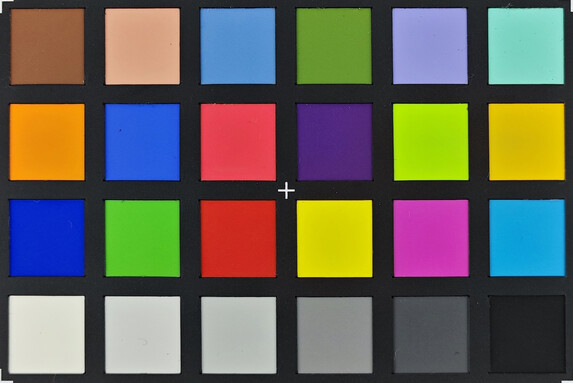

Accessories and warranty - A mere 12-month warranty
The Xiaomi 13 comes with a modular 67-watt power adapter with a USB-A port. If you decide to go with an import device, you'll receive a model that is compatible with the Type A electrical plug. However, TradingShenzhen, who loaned us the device, has included an appropriate adapter. Also inside the box are a corresponding USB cable (Type A to C), a SIM ejector tool and a clear silicone case.
Xiaomi unfortunately only provides a 12-month warranty on the phone, but your warranty rights are not affected by this (where applicable).
Input devices and operation - Optical fingerprint scanner
The capacitive touchscreen on the Xiaomi 13 can recognise up to ten simultaneous touch events and has a touch sampling rate of up to 240Hz, which is half of what the predecessor is capable of. But you won't notice this in everyday use. The phone responds quickly and accurately to inputs, and the screen's glass surface is exceptionally smooth and lets you slide your finger across effortlessly.
The vibration motor produces a nice tactile haptic feedback and is hardly audible when running. The one-handed mode took a cue from the iPhone and works very well. Xiaomi has also implemented many other gestures designed to make using the phone easier.
An optical fingerprint scanner built into the display can be used for biometric authentication. During our testing, the scanner delivered a high recognition rate and promptly unlocked the Xiaomi 13. Apart from the fingerprint reader, you can also use the front camera to unlock the phone, though it is less secure.
Display - Ultra-bright AMOLED capable of up to 120Hz
The display on the Xiaomi 13 measures 6.36 inches (16.15 cm) and has a Full HD resolution – equivalent to a pixel density of 400 PPI. The smartphone also supports all modern HDR standards, including HDR10+ and Dolby Vision. Less up to date, however, is the screen's adaptive refresh rate, which can only switch dynamically between 60, 90 and 120Hz.
With the ambient light sensor enabled, the screen had a peak brightness of 1,217 cd/m² when displaying a fully white image, which is a substantial improvement over the predecessor (max. 875 cd/m²). Whilst Xiaomi promises a local peak brightness of 1,900 nits, we only managed to get a maximum of 1,756 cd/m² (APL18) out of the review unit. Still an excellent result nonetheless. If you prefer to adjust screen brightness manually, you'll have up to 506 cd/m² at your disposal.
As with most smartphones with an OLED panel, the Xiaomi 13 has issues with flicker. At the lowest brightness, the display flickers at a fairly rough 162 to 488Hz. The waveform becomes smoother with increasing brightness. At brightness levels above 65%, we were only able to detect flicker amounting to the refresh rate. So if you are sensitive to the use of pulse-wave modulation, you should enable the DC dimming option (anti-flicker mode). Once it was activated, we could only detect flicker equalling to the refresh rate across the entire brightness range.
| |||||||||||||||||||||||||
Brightness Distribution: 98 %
Center on Battery: 1209 cd/m²
Contrast: ∞:1 (Black: 0 cd/m²)
ΔE ColorChecker Calman: 1.2 | ∀{0.5-29.43 Ø4.77}
ΔE Greyscale Calman: 2.1 | ∀{0.09-98 Ø5}
98.6% sRGB (Calman 2D)
Gamma: 2.26
CCT: 6504 K
| Xiaomi 13 OLED, 2400x1080, 6.4" | Samsung Galaxy S22 AMOLED, 2340x1080, 6.1" | Motorola Edge 30 Ultra pOLED, 2400x1080, 6.7" | Google Pixel 7 Pro OLED, 3120x1440, 6.7" | Oppo Find X5 Pro AMOLED, 3216x1440, 6.7" | Apple iPhone 14 Pro Super Retina XDR OLED, 2556x1179, 6.1" | Xiaomi 12 OLED, 2400x1080, 6.3" | |
|---|---|---|---|---|---|---|---|
| Screen | -19% | -2% | 12% | 3% | -2% | -22% | |
| Brightness middle (cd/m²) | 1209 | 853 -29% | 1020 -16% | 1022 -15% | 746 -38% | 1046 -13% | 867 -28% |
| Brightness (cd/m²) | 1208 | 858 -29% | 1020 -16% | 1025 -15% | 744 -38% | 1049 -13% | 867 -28% |
| Brightness Distribution (%) | 98 | 96 -2% | 96 -2% | 99 1% | 97 -1% | 98 0% | 98 0% |
| Black Level * (cd/m²) | |||||||
| Colorchecker dE 2000 * | 1.2 | 1.9 -58% | 1 17% | 0.9 25% | 0.9 25% | 1.2 -0% | 1.7 -42% |
| Colorchecker dE 2000 max. * | 3 | 3.2 -7% | 2.8 7% | 2.1 30% | 1.6 47% | 3.1 -3% | 4.4 -47% |
| Greyscale dE 2000 * | 2.1 | 1.9 10% | 2.1 -0% | 1.1 48% | 1.6 24% | 1.7 19% | 1.8 14% |
| Gamma | 2.26 97% | 2.07 106% | 2.29 96% | 2.22 99% | 2.23 99% | 2.19 100% | 2.2 100% |
| CCT | 6504 100% | 6460 101% | 6502 100% | 6650 98% | 6499 100% | 6538 99% | 6762 96% |
* ... smaller is better
Screen Flickering / PWM (Pulse-Width Modulation)
| Screen flickering / PWM detected | 488 Hz | ||
The display backlight flickers at 488 Hz (worst case, e.g., utilizing PWM) . The frequency of 488 Hz is relatively high, so most users sensitive to PWM should not notice any flickering. However, there are reports that some users are still sensitive to PWM at 500 Hz and above, so be aware. In comparison: 53 % of all tested devices do not use PWM to dim the display. If PWM was detected, an average of 8084 (minimum: 5 - maximum: 343500) Hz was measured. | |||
We examined the panel's colour reproduction more closely using a spectrophotometer and the Calman analysis software. The Xiaomi 13's display is most true to life in the "Original" colour mode, but this option only targets the smaller sRGB colour gamut. In this mode, there aren't any perceivable colour differences. The default "Vivid" mode makes colours appear more saturated and has a much cooler white balance. However, it supports the larger DCI-P3 colour space.
Display Response Times
| ↔ Response Time Black to White | ||
|---|---|---|
| 1.16 ms ... rise ↗ and fall ↘ combined | ↗ 0.6315 ms rise | |
| ↘ 0.533 ms fall | ||
| The screen shows very fast response rates in our tests and should be very well suited for fast-paced gaming. In comparison, all tested devices range from 0.1 (minimum) to 240 (maximum) ms. » 5 % of all devices are better. This means that the measured response time is better than the average of all tested devices (20.2 ms). | ||
| ↔ Response Time 50% Grey to 80% Grey | ||
| 1.67 ms ... rise ↗ and fall ↘ combined | ↗ 0.8355 ms rise | |
| ↘ 0.834 ms fall | ||
| The screen shows very fast response rates in our tests and should be very well suited for fast-paced gaming. In comparison, all tested devices range from 0.165 (minimum) to 636 (maximum) ms. » 7 % of all devices are better. This means that the measured response time is better than the average of all tested devices (31.6 ms). | ||
Performance - Snapdragon 8 Gen 2 in Xiaomi 13
The Xiaomi 13 sports the latest Snapdragon 8 Gen 2 made by Qualcomm, which is flanked by 8 GB of LPDDR5x memory in our review unit. The high-end SoC comprises a total of four clusters. The first has a single Prime core that can run at up to 3.2 GHz. The two performance clusters feature two Cortex A715 cores and two Cortex A710 cores (each capable of up to 2.8 GHz) respectively, whilst the final cluster has three Cortex A510 cores for running tasks at high efficiency.
In terms of pure CPU speed, the device is leaps and bounds ahead of the Xiaomi 12 (Snapdragon 8 Gen 1). It scored 19% higher in the Geekbench single-core test, with the lead extending to 42% in the multi-core test. What's more, the SoC even showed great performance gains over the Snapdragon 8+ Gen 1 (+11% / +20%).
Not only is the phone's performance fantastic in day-to-day use, but we also couldn't find any faults with it in benchmarks. Although the Xiaomi 13 trails behind the Motorola Edge 30 Ultra in Basemark OS II, it beats the Motorala phone by a larger margin in AnTuTu.
Evaluating the phone's AI performance isn't such an easy undertaking. AIMark didn't run on the Xiaomi 13. In Procyon, the device is only marginally faster than the Edge 30 Ultra. The Pixel 7 Pro and iPhone 14 Pro completely blew away the Xiaomi in Geekbench ML. But this could also be due to poor driver optimisation. Upcoming reviews of smartphones with the Snapdragon 8 Gen 2 will shed more light on this topic.
| UL Procyon AI Inference for Android - Overall Score NNAPI | |
| Oppo Find X5 Pro | |
| Google Pixel 7 Pro | |
| Average of class Smartphone (3769 - 81594, n=133, last 2 years) | |
| Xiaomi 13 | |
| Average Qualcomm Snapdragon 8 Gen 2 (11338 - 16880, n=21) | |
| Motorola Edge 30 Ultra | |
| Geekbench ML | |
| 0.5 TensorFlow Lite CPU 0.5 | |
| Apple iPhone 14 Pro | |
| Xiaomi 13 | |
| Average Qualcomm Snapdragon 8 Gen 2 (547 - 608, n=3) | |
| Motorola Edge 30 Ultra | |
| Google Pixel 7 Pro | |
| Oppo Find X5 Pro | |
| 0.5 TensorFlow Lite GPU | |
| Apple iPhone 14 Pro | |
| Motorola Edge 30 Ultra | |
| Average Qualcomm Snapdragon 8 Gen 2 (1833 - 2202, n=3) | |
| Xiaomi 13 | |
| Oppo Find X5 Pro | |
| Google Pixel 7 Pro | |
| 0.5 TensorFlow Lite NNAPI / Core ML | |
| Apple iPhone 14 Pro | |
| Google Pixel 7 Pro | |
| Motorola Edge 30 Ultra | |
| Xiaomi 13 | |
| Average Qualcomm Snapdragon 8 Gen 2 (401 - 633, n=3) | |
| Oppo Find X5 Pro | |
The Adreno 740 integrated in the SoC is responsible for graphics processing. The GPU's performance is a bit of a mixed bag. In older benchmarks with OpenGL ES API, the new GPU is sometimes slower than the Adreno 730 on the previous Snapdragon 8 – but this could likewise be caused by a driver issue. Once the Vulkan API is used, we saw performance gains of up to 34%, and the Xiaomi 13 even outperformed the current-gen iPhone.
GFXBench (DX / GLBenchmark) 2.7: T-Rex Onscreen | 1920x1080 T-Rex Offscreen
GFXBench 3.0: on screen Manhattan Onscreen OGL | 1920x1080 1080p Manhattan Offscreen
GFXBench 3.1: on screen Manhattan ES 3.1 Onscreen | 1920x1080 Manhattan ES 3.1 Offscreen
GFXBench: on screen Car Chase Onscreen | 1920x1080 Car Chase Offscreen | on screen Aztec Ruins High Tier Onscreen | 2560x1440 Aztec Ruins High Tier Offscreen | on screen Aztec Ruins Normal Tier Onscreen | 1920x1080 Aztec Ruins Normal Tier Offscreen | 3840x2160 4K Aztec Ruins High Tier Offscreen
| 3DMark / Wild Life Extreme Unlimited | |
| Xiaomi 13 | |
| Apple iPhone 14 Pro | |
| Motorola Edge 30 Ultra | |
| Oppo Find X5 Pro | |
| Xiaomi 12 | |
| Samsung Galaxy S22 | |
| Google Pixel 7 Pro | |
| 3DMark / Wild Life Extreme | |
| Xiaomi 13 | |
| Apple iPhone 14 Pro | |
| Motorola Edge 30 Ultra | |
| Xiaomi 12 | |
| Oppo Find X5 Pro | |
| Samsung Galaxy S22 | |
| Google Pixel 7 Pro | |
| 3DMark / Wild Life Unlimited Score | |
| Xiaomi 13 | |
| Apple iPhone 14 Pro | |
| Motorola Edge 30 Ultra | |
| Oppo Find X5 Pro | |
| Xiaomi 12 | |
| Samsung Galaxy S22 | |
| Google Pixel 7 Pro | |
| 3DMark / Sling Shot Extreme (ES 3.1) Unlimited Physics | |
| Motorola Edge 30 Ultra | |
| Google Pixel 7 Pro | |
| Xiaomi 12 | |
| Xiaomi 13 | |
| Samsung Galaxy S22 | |
| Oppo Find X5 Pro | |
| 3DMark / Sling Shot Extreme (ES 3.1) Unlimited Graphics | |
| Xiaomi 13 | |
| Motorola Edge 30 Ultra | |
| Xiaomi 12 | |
| Oppo Find X5 Pro | |
| Samsung Galaxy S22 | |
| Google Pixel 7 Pro | |
| 3DMark / Sling Shot Extreme (ES 3.1) Unlimited | |
| Motorola Edge 30 Ultra | |
| Xiaomi 13 | |
| Xiaomi 12 | |
| Oppo Find X5 Pro | |
| Google Pixel 7 Pro | |
| Samsung Galaxy S22 | |
| GFXBench (DX / GLBenchmark) 2.7 / T-Rex Onscreen | |
| Motorola Edge 30 Ultra | |
| Xiaomi 12 | |
| Google Pixel 7 Pro | |
| Xiaomi 13 | |
| Samsung Galaxy S22 | |
| Oppo Find X5 Pro | |
| Apple iPhone 14 Pro | |
| GFXBench (DX / GLBenchmark) 2.7 / T-Rex Offscreen | |
| Apple iPhone 14 Pro | |
| Motorola Edge 30 Ultra | |
| Xiaomi 12 | |
| Xiaomi 13 | |
| Oppo Find X5 Pro | |
| Samsung Galaxy S22 | |
| Google Pixel 7 Pro | |
| GFXBench 3.0 / Manhattan Onscreen OGL | |
| Motorola Edge 30 Ultra | |
| Xiaomi 12 | |
| Xiaomi 13 | |
| Samsung Galaxy S22 | |
| Google Pixel 7 Pro | |
| Oppo Find X5 Pro | |
| Apple iPhone 14 Pro | |
| GFXBench 3.0 / 1080p Manhattan Offscreen | |
| Apple iPhone 14 Pro | |
| Xiaomi 13 | |
| Motorola Edge 30 Ultra | |
| Xiaomi 12 | |
| Samsung Galaxy S22 | |
| Oppo Find X5 Pro | |
| Google Pixel 7 Pro | |
| GFXBench 3.1 / Manhattan ES 3.1 Onscreen | |
| Xiaomi 12 | |
| Xiaomi 13 | |
| Motorola Edge 30 Ultra | |
| Samsung Galaxy S22 | |
| Apple iPhone 14 Pro | |
| Oppo Find X5 Pro | |
| Google Pixel 7 Pro | |
| GFXBench 3.1 / Manhattan ES 3.1 Offscreen | |
| Apple iPhone 14 Pro | |
| Xiaomi 13 | |
| Motorola Edge 30 Ultra | |
| Xiaomi 12 | |
| Samsung Galaxy S22 | |
| Oppo Find X5 Pro | |
| Google Pixel 7 Pro | |
| GFXBench / Car Chase Onscreen | |
| Xiaomi 13 | |
| Motorola Edge 30 Ultra | |
| Xiaomi 12 | |
| Samsung Galaxy S22 | |
| Apple iPhone 14 Pro | |
| Oppo Find X5 Pro | |
| Google Pixel 7 Pro | |
| GFXBench / Car Chase Offscreen | |
| Apple iPhone 14 Pro | |
| Xiaomi 13 | |
| Motorola Edge 30 Ultra | |
| Xiaomi 12 | |
| Google Pixel 7 Pro | |
| Samsung Galaxy S22 | |
| Oppo Find X5 Pro | |
| GFXBench / Aztec Ruins High Tier Onscreen | |
| Xiaomi 12 | |
| Motorola Edge 30 Ultra | |
| Xiaomi 13 | |
| Apple iPhone 14 Pro | |
| Samsung Galaxy S22 | |
| Oppo Find X5 Pro | |
| Google Pixel 7 Pro | |
| GFXBench / Aztec Ruins High Tier Offscreen | |
| Xiaomi 13 | |
| Motorola Edge 30 Ultra | |
| Apple iPhone 14 Pro | |
| Oppo Find X5 Pro | |
| Xiaomi 12 | |
| Google Pixel 7 Pro | |
| Samsung Galaxy S22 | |
| GFXBench / Aztec Ruins Normal Tier Onscreen | |
| Xiaomi 13 | |
| Motorola Edge 30 Ultra | |
| Xiaomi 12 | |
| Samsung Galaxy S22 | |
| Apple iPhone 14 Pro | |
| Oppo Find X5 Pro | |
| Google Pixel 7 Pro | |
| GFXBench / Aztec Ruins Normal Tier Offscreen | |
| Xiaomi 13 | |
| Apple iPhone 14 Pro | |
| Motorola Edge 30 Ultra | |
| Xiaomi 12 | |
| Oppo Find X5 Pro | |
| Google Pixel 7 Pro | |
| Samsung Galaxy S22 | |
| GFXBench / 4K Aztec Ruins High Tier Offscreen | |
| Xiaomi 13 | |
| Motorola Edge 30 Ultra | |
| Apple iPhone 14 Pro | |
| Google Pixel 7 Pro | |
Basemark GPUScore
Browser speed is very high both in everyday use and in benchmarks. There is nothing to complain about the phone in this regard.
| Jetstream 2 - 2.0 Total Score | |
| Apple iPhone 14 Pro (Safari 16) | |
| Average of class Smartphone (23.8 - 387, n=148, last 2 years) | |
| Xiaomi 13 (Chrome 108) | |
| Average Qualcomm Snapdragon 8 Gen 2 (62.7 - 179.2, n=23) | |
| Motorola Edge 30 Ultra (Chrome 105) | |
| Xiaomi 12 (Chrome 99.0.4844.58) | |
| Oppo Find X5 Pro (Chrome 99) | |
| Google Pixel 7 Pro (Chrome 106) | |
| Samsung Galaxy S22 (Chrome 100.0.4896.79) | |
| Speedometer 2.0 - Result 2.0 | |
| Apple iPhone 14 Pro (Safari 16) | |
| Average of class Smartphone (15.2 - 643, n=120, last 2 years) | |
| Average Qualcomm Snapdragon 8 Gen 2 (62.9 - 225, n=18) | |
| Xiaomi 13 (Chrome 108) | |
| Samsung Galaxy S22 (Chrome 100.0.4896.79) | |
| Xiaomi 12 (Chrome 99.0.4844.58) | |
| Oppo Find X5 Pro (Chrome 99) | |
| Google Pixel 7 Pro (Chrome 106) | |
| Motorola Edge 30 Ultra (Chrome 105) | |
| WebXPRT 4 - Overall | |
| Apple iPhone 14 Pro (Safari 16) | |
| Average of class Smartphone (27 - 306, n=144, last 2 years) | |
| Xiaomi 13 (Chrome 108) | |
| Average Qualcomm Snapdragon 8 Gen 2 (28 - 183, n=22) | |
| Motorola Edge 30 Ultra (Chrome 105) | |
| Google Pixel 7 Pro (Chrome 106) | |
| Octane V2 - Total Score | |
| Apple iPhone 14 Pro (Safari 16) | |
| Average of class Smartphone (2228 - 126661, n=195, last 2 years) | |
| Average Qualcomm Snapdragon 8 Gen 2 (19870 - 65418, n=25) | |
| Google Pixel 7 Pro (Chrome 106) | |
| Xiaomi 13 (Chrome 108) | |
| Samsung Galaxy S22 (Chrome 100.0.4896.79) | |
| Oppo Find X5 Pro (Chrome 99) | |
| Xiaomi 12 (Chrome 99.0.4844.58) | |
| Motorola Edge 30 Ultra (Chrome 105) | |
| Mozilla Kraken 1.1 - Total | |
| Samsung Galaxy S22 (Chrome 100.0.4896.79) | |
| Average of class Smartphone (257 - 28190, n=155, last 2 years) | |
| Oppo Find X5 Pro (Chrome 99) | |
| Motorola Edge 30 Ultra (Chrome 105) | |
| Average Qualcomm Snapdragon 8 Gen 2 (602 - 1837, n=22) | |
| Google Pixel 7 Pro (Chrome 106) | |
| Xiaomi 12 (Chrome 99.0.4844.58) | |
| Xiaomi 13 (Chrome 108) | |
| Apple iPhone 14 Pro (Safari 16) | |
* ... smaller is better
The Xiaomi 13 is one of the first smartphones to make use of UFS 4.0 storage. In particular, this new standard offers a major boost in sequential read and write speeds.
| Xiaomi 13 | Samsung Galaxy S22 | Motorola Edge 30 Ultra | Google Pixel 7 Pro | Oppo Find X5 Pro | Xiaomi 12 | Average 256 GB UFS 4.0 Flash | Average of class Smartphone | |
|---|---|---|---|---|---|---|---|---|
| AndroBench 3-5 | -51% | -32% | -57% | -60% | -32% | -6% | -32% | |
| Sequential Read 256KB (MB/s) | 3454.01 | 1486 -57% | 1717.77 -50% | 1346.78 -61% | 1410 -59% | 1851 -46% | 3664 ? 6% | 2245 ? -35% |
| Sequential Write 256KB (MB/s) | 2722.77 | 993 -64% | 1363.58 -50% | 874.73 -68% | 894 -67% | 1417 -48% | 2701 ? -1% | 1877 ? -31% |
| Random Read 4KB (MB/s) | 393.81 | 273 -31% | 349.08 -11% | 219.01 -44% | 183.7 -53% | 325.2 -17% | 381 ? -3% | 298 ? -24% |
| Random Write 4KB (MB/s) | 536.76 | 257.6 -52% | 446.25 -17% | 253.18 -53% | 210.4 -61% | 437.5 -18% | 405 ? -25% | 344 ? -36% |
Gaming - Brimming with gaming power
The Adreno 740 provides powerful graphics acceleration in the Xiaomi 13. It allows the phone to run a demanding game like Genshin Impact at max settings with seemingly effortless ease. The same is true for PUBG Mobile; you can play this game on the device without any compromise. All the framerate figures were obtained using a tool developed by our partner GameBench.
With high refresh rates, decent dual speakers and superb performance, there is nothing in the way of you enjoying games on the Xiaomi 13.
Emissions - Great thermal management
Temperature
Surface temperatures on the Xiaomi 13 were consistently excellent throughout our testing: even under load, the chassis only crossed the 30°C (86°F) mark in a few spots.
Whilst the Xiaomi 12 experienced issues with overheating during our stress test, the Xiaomi 13 seems to have left this problem behind in the past. The phone had a very decent showing in 3DMark stress tests and saw performance drop of slightly more than 20% due to throttling. This is a huge step forward compared with the Xiaomi 12, whose performance plunged by 50% over the course of the stress tests. Featuring a more powerful Snapdragon 8 Gen 2, the Xiaomi 13 offers better performance than the iPhone 14 Pro over an extended period and generated twice as many frames as its predecessor.
(+) The maximum temperature on the upper side is 30.9 °C / 88 F, compared to the average of 35.2 °C / 95 F, ranging from 21.9 to 247 °C for the class Smartphone.
(+) The bottom heats up to a maximum of 29.8 °C / 86 F, compared to the average of 34 °C / 93 F
(+) In idle usage, the average temperature for the upper side is 24.5 °C / 76 F, compared to the device average of 32.9 °C / 91 F.
3DMark Wild Life Stress Test
| 3DMark | |
| Wild Life Stress Test Stability | |
| Apple iPhone 14 Pro | |
| Xiaomi 13 | |
| Google Pixel 7 Pro | |
| Oppo Find X5 Pro | |
| Motorola Edge 30 Ultra | |
| Samsung Galaxy S22 | |
| Wild Life Extreme Stress Test | |
| Xiaomi 13 | |
| Google Pixel 7 Pro | |
| Apple iPhone 14 Pro | |
| Motorola Edge 30 Ultra | |
| Oppo Find X5 Pro | |
| Samsung Galaxy S22 | |
Speakers
Even though the dual speakers on the Xiaomi 13 have Dolby Atmos certification, this doesn't really mean that they provide a spatial audio experience. That said, the speakers do offer a relatively good sound with decent bass, as long as you don't turn up the volume too high.
Those who prefer to use an external audio device can connect it to the phone via the USB port. A USB audio adapter has to be purchased separately should you require an audio jack. The phone also features Bluetooth 5.3 for wireless audio and supports a wide range of codecs (SBC, AAC, aptX, aptX HD, aptX Adative, aptX TWS+, LDAC and LHDC V1-5).
Xiaomi 13 audio analysis
(+) | speakers can play relatively loud (91.4 dB)
Bass 100 - 315 Hz
(-) | nearly no bass - on average 20.8% lower than median
(+) | bass is linear (6% delta to prev. frequency)
Mids 400 - 2000 Hz
(±) | reduced mids - on average 5.5% lower than median
(+) | mids are linear (4.4% delta to prev. frequency)
Highs 2 - 16 kHz
(±) | higher highs - on average 5.8% higher than median
(+) | highs are linear (4.8% delta to prev. frequency)
Overall 100 - 16.000 Hz
(±) | linearity of overall sound is average (16.2% difference to median)
Compared to same class
» 6% of all tested devices in this class were better, 5% similar, 90% worse
» The best had a delta of 11%, average was 35%, worst was 134%
Compared to all devices tested
» 25% of all tested devices were better, 5% similar, 69% worse
» The best had a delta of 4%, average was 24%, worst was 134%
Samsung Galaxy S22 audio analysis
(+) | speakers can play relatively loud (89.5 dB)
Bass 100 - 315 Hz
(-) | nearly no bass - on average 26.3% lower than median
(±) | linearity of bass is average (10.2% delta to prev. frequency)
Mids 400 - 2000 Hz
(±) | higher mids - on average 6.2% higher than median
(+) | mids are linear (4.4% delta to prev. frequency)
Highs 2 - 16 kHz
(±) | higher highs - on average 5.6% higher than median
(+) | highs are linear (5.5% delta to prev. frequency)
Overall 100 - 16.000 Hz
(±) | linearity of overall sound is average (19% difference to median)
Compared to same class
» 24% of all tested devices in this class were better, 9% similar, 67% worse
» The best had a delta of 11%, average was 35%, worst was 134%
Compared to all devices tested
» 44% of all tested devices were better, 8% similar, 48% worse
» The best had a delta of 4%, average was 24%, worst was 134%
Battery life - 4,500 mAh with more stamina
Power consumption
The Xiaomi 13's power consumption is excellent. Comparing the Xiaomi phone directly with the Vivo X90 Pro+ really demonstrates how efficient the device is relative to a competitor with an identical SoC.
The Xiaomi 13 uses the same charging technology as its predecessor and can charge up fully within 50 minutes using the included 67-watt adapter. During our testing, the 80% mark was reached within just half an hour. Furthermore, the device supports wireless charging at up to 50 watts and reverse wireless charging at up to 10 watts.
| Off / Standby | |
| Idle | |
| Load |
|
Key:
min: | |
| Xiaomi 13 4500 mAh | Samsung Galaxy S22 3700 mAh | Motorola Edge 30 Ultra 4610 mAh | Google Pixel 7 Pro 5000 mAh | Oppo Find X5 Pro 5000 mAh | Apple iPhone 14 Pro 3200 mAh | Average Qualcomm Snapdragon 8 Gen 2 | Average of class Smartphone | |
|---|---|---|---|---|---|---|---|---|
| Power Consumption | -35% | -18% | -19% | -28% | -5% | -73% | -58% | |
| Idle Minimum * (Watt) | 0.76 | 0.69 9% | 0.74 3% | 0.78 -3% | 1.24 -63% | 0.56 26% | 1.036 ? -36% | 0.847 ? -11% |
| Idle Average * (Watt) | 1.1 | 1.19 -8% | 1.84 -67% | 1.61 -46% | 1.39 -26% | 1.37 -25% | 1.766 ? -61% | 1.445 ? -31% |
| Idle Maximum * (Watt) | 1.13 | 1.26 -12% | 1.86 -65% | 1.63 -44% | 1.42 -26% | 1.42 -26% | 1.94 ? -72% | 1.629 ? -44% |
| Load Average * (Watt) | 2.99 | 6.97 -133% | 2.75 8% | 3.29 -10% | 3.58 -20% | 3.42 -14% | 7.22 ? -141% | 6.97 ? -133% |
| Load Maximum * (Watt) | 6.63 | 8.85 -33% | 4.54 32% | 6.01 9% | 6.99 -5% | 5.56 16% | 10.4 ? -57% | 11.2 ? -69% |
* ... smaller is better
Power consumption: Geekbench (150 cd/m²)
Power consumption: GFXBench (150 cd/m²)
Battery life
The 4,500 mAh battery kept the Xiaomi 13 going for a very long time in our test, leaving the rest of the competition in the dust. Only the iPhone 14 Pro managed to last much longer when playing back the test video.
| Xiaomi 13 4500 mAh | Samsung Galaxy S22 3700 mAh | Motorola Edge 30 Ultra 4610 mAh | Google Pixel 7 Pro 5000 mAh | Oppo Find X5 Pro 5000 mAh | Apple iPhone 14 Pro 3200 mAh | Xiaomi 12 4500 mAh | |
|---|---|---|---|---|---|---|---|
| Battery runtime | -28% | -17% | -35% | -25% | -9% | -19% | |
| Reader / Idle (h) | 49.7 | 36.4 -27% | 36.8 -26% | 20.2 -59% | 21.2 -57% | 44.3 -11% | 42.6 -14% |
| H.264 (h) | 20.4 | 14.8 -27% | 19.8 -3% | 20.2 -1% | 19 -7% | 23.3 14% | 14.8 -27% |
| WiFi v1.3 (h) | 17 | 11.3 -34% | 14.5 -15% | 11.3 -34% | 13.1 -23% | 13.5 -21% | 12.7 -25% |
| Load (h) | 7.1 | 5.4 -24% | 5.4 -24% | 3.8 -46% | 6.1 -14% | 5.9 -17% | 6.4 -10% |
Pros
Cons
Verdict - Compact powerhouse with few drawbacks
The Xiaomi 13 is an improvement over its predecessor in almost every aspect whilst remaining relatively compact for a high-end smartphone. Some of its features worth highlighting include the optimised thermal management, exceptional battery life and upgrade to the secondary lenses on the triple-camera system, which has now finally received optical zoom capability.
The Xiaomi 13 is a superb premium smartphone that is still missing some features.
The cooperation with Leica isn't immediately noticeable on the phone yet. It showed hardly any difference compared with its predecessor (without Leica branding) especially in terms of the camera's colour science. During macro shots, the algorithm has a tendency to go overboard with the contrast, which certainly isn't going to suit everybody's taste. Although the front camera produces decent images, autofocus or better video performance should have been a given at this price range. We also wish that the phone had a faster USB port as well as eSIM support.
That said, these shortcomings are not deal-breakers. Xiaomi has managed to create a fantastic smartphone that is enjoyable to use in everyday life. Those looking at the import version should take note that it doesn't support a few major LTE frequency bands in Europe but is significantly cheaper.
The Galaxy S22 (and its successor S23), the Pixel 7 Pro and the Motorola Edge 30 Ultra are great alternatives to the Xiaomi 13. If form factor is important to you and you prefer small phones, then the Zenfone 9 might be worth a look.
Price and availability
At the time of writing this review, the Xiaomi 13 is only available as an import device, for instance from TradingShenzhen (who kindly loaned us the review unit). But you can already find cases and other accessories for the phone on Amazon.
Transparency
The selection of devices to be reviewed is made by our editorial team. The test sample was provided to the author as a loan by the manufacturer or retailer for the purpose of this review. The lender had no influence on this review, nor did the manufacturer receive a copy of this review before publication. There was no obligation to publish this review. As an independent media company, Notebookcheck is not subjected to the authority of manufacturers, retailers or publishers.
This is how Notebookcheck is testing
Every year, Notebookcheck independently reviews hundreds of laptops and smartphones using standardized procedures to ensure that all results are comparable. We have continuously developed our test methods for around 20 years and set industry standards in the process. In our test labs, high-quality measuring equipment is utilized by experienced technicians and editors. These tests involve a multi-stage validation process. Our complex rating system is based on hundreds of well-founded measurements and benchmarks, which maintains objectivity. Further information on our test methods can be found here.
Xiaomi 13
- 02/07/2023 v7 (old)
Daniel Schmidt




